Bells chime through the wet air and the odd manic high-pitched wail of urging in Tibetan rips over the grassland. Plodding through the pine and spruce are the sagging, deflated bodies of mules lugging packs that dwarf them. Their day thus far has been a crushingly long one.
Light beige coloured hats appear too, and the bodies beneath them lithely take in steps, stalking along in between the ten mules. They are the muleteers and what a sight they and the mules make.
After a 50 km day they have a right to slump, scream, and even waver in their commitment. From my own perspective, these bodies that smoke, steam, and pace towards us have the look of a golden apparition. They are one of those very necessary reminders that all of the past is not done; that the mules and the hands that guide them still do have a role or two to play yet.
On the backs of those mules, tents, supplies, treats and extra layers for over twenty people lie packed up. Our team of students who’ve come for their own little adventure line the grass-line to welcome our heroes. They’ve made it intact and our kit has arrived along with them.
Here in Yunnan’s northwest at just over 3,400 meters our trek is in full swing, under a sky that suggests it just might throw a deluge at us in earnest. Autumn’s rain hasn’t quite let up and in the magic moments of seconds, the skies can open up, or they can entirely shut down.
Our muleteers arrive, somehow sporting smiles. Two aged men with the lines and cords of strength from years of work and two handsome young men with the reckless good looks and strides of born gunslingers.
Above us to the south is a wall that encases the sky in crags and bulky grey hides. It eases further east into an ever-dwindling corridor where the winds play and the spaces tighten.
The horsemen are unrelenting, urging, and prodding the mules onwards until they are encircled by our group who has been waiting for nearly three hours. There is no slumping or premature ‘breaks’ as the mules are carefully unloaded. Quick release knots are unbound, and sacks quickly lowered to the turf. Tents are divvied out and the students effortlessly – in most cases – erect their colourful sheets in minutes.
Then and only then, when all the kit is secure, do the horsemen smile and ease off to the fire that rattles within a summer herders home.
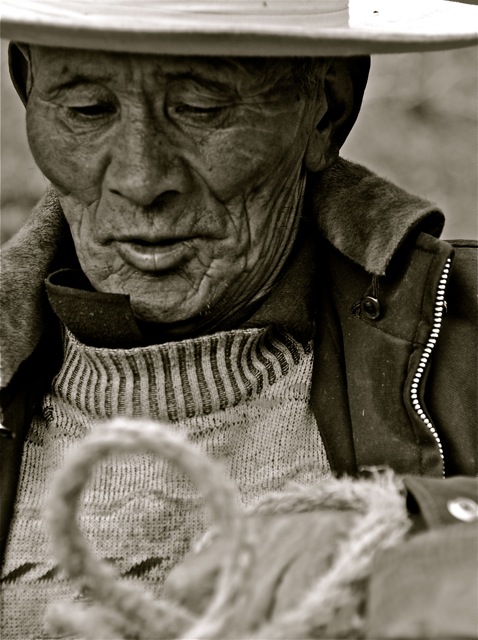
Our eldest muleteer, at 72, does what he has done for decades…prepare one of his brilliant knots to secure cargo aboard a mule
One of the horsemen who acts as the leader, Songjè, typifies the travelers of old in this region of mountains.
Both his age and energy are throwbacks to the caravans that once pushed their way along the Tea Horse Road and other caravan trails. Fearless because there wasn’t many other choices and the only vanities were perhaps that he – better than most – knew himself almost to a cell. Along the mountain corridors nothing would move, trade would not ‘trade’, and things would simply sit still without these lean titan’s relentless pushing and mountain bred abilities. It is they that fascinate me, even after dozens of treks and expeditions with horsemen like them, through landscapes that should take the eyes away. These muleteers serve as a kind of ideal sentinel to Himalayan travel, even as their precious skill sets and unpretentious graft slowly fade. Songjè’s eyes glitter like black gems and his entire countenance seems to buzz with strength. I find out that he is 61 years old.
Even though there are three far younger and bigger horsemen, Songjè has an effortless power and an uncanny ability to speak precisely when needed; a skill that befitting a leader both in work and deed. Everyone gives him an ear, and gives him space. Both mules and humans respond to his authority without hesitation. I know immediately that, beyond the students own relative comforts and happiness, this is a man to keep content.
Our entire unit of two-legged mortals numbers almost thirty and our target is a body of hollowed-out stone with a sacred lake tucked within. The Tibetans refer to it as the ‘Pillar of Gold’, though there are many ‘pillars’ of ominous spires that shoot up. The precise destination is nothing more than a rounded, monochromatic hump of stone and debris that lies within a grand expanse of grey space. Our route will ascend over a thousand meters to a lifeless, windblown space that pummels emptiness into the psyche. It is not the first time I’ve been to this little natural wonder but every time I ascend, the elements conspire to present an altogether unfamiliar scene.
Sleep our first night, to all but a few dealing with mild altitude issues, comes swift in the little tents. The horseman talk until they too drift and soon there is nothing but the chimes of the bells on the mules, who chomp away at the free grass. Nighttime subdues everything as bodies tuck deep into bags.
Close to noon on the next day our group emerges from a silent alpine layer of mosses and dark trees into ever more ragged landscapes where rocks take over from green . Our camp site sits on a ridge looking down at the nearly 600 meters we have ascended. On the south side of camp a sheer drop to a silver gash that is a stream hems us in, while on the north and northeast the mountains rise ever more and a single path cuts diagonally like a ledge. Two ancient stone dwellings, nothing more than foundations, stil provide a base by which we set up our cooking camp and a windproof sleeping nook.
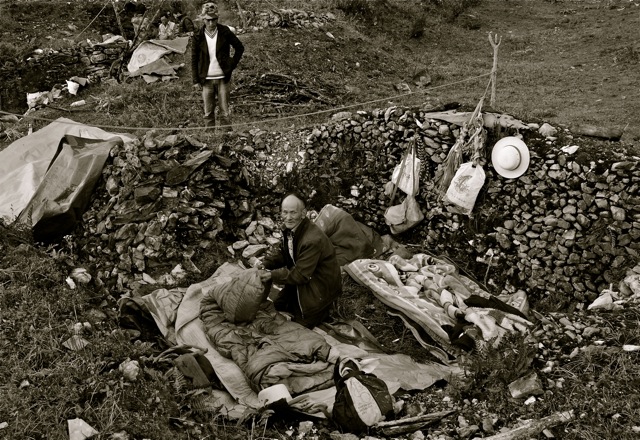
Our elder statesman prepares his bedding within the ancient foundation that other herders or pilgrims created to hide from the winds
The students eyes have widened as the altitudes offer ever broadening horizons, until finally jagged teeth start appearing. East is where these teeth appear and it is east that we are travelling.
Our horsemen waste no time in unpacking and the ‘nook’ quickly becomes a shelter for five. There is an energy and ability to remain firmly in the present on such undertakings which is perhaps why, those who participate in such journeys are often so vibrant. It is vibrancy which creates integrity.
Ado our cook, somehow maintains a classy decorum amidst the winds, swirling smoke, and leather-skinned horsemen. He is liquid efficiency. He summons, issues commands and does it all flawlessly as he immediately prepares the ‘must-have-teas’: ginger tea, hot water (for my tea), and butter tea for the horsemen and guides. Tsutrim, a big smiling horsemen whose skin has been darkened by a lifetime of sun, secures supplies, tying them down to prevent the winds from taking them off into the heights.
Landscapes and their backdrop of elements overwhelm everything as they literally become the entire ‘present tense’ and our little world fits into this ideal. As we erect tents a steel coloured mist moves in teasing with biting cold licks before giving way…only to return. As tents are erected and our youthful troupe exchange little thoughts with eachother I am again drawn to the two elder horsemen who in rapid time have created their lairs and snuggled close to the fire.
The horsemen will soon head out for their own little expedition, without their mounts. They will, with juniper bushes in hand, ascend to the sacred lake which lies 45 minutes further up in the mists to pay homage to one of the elements still holy to the Tibetans, a body of still water and a remnant of the pre-Buddhist Bön religion, which was largely animistic.
Lakes, mountains, and trees are still worshipped with a reverence that pre-dates the organized Buddhist teachings. These elements reach back to a primordial time when the ‘element worshippers’ viewed the living earth as totems. To scale a peak was a crime, to cut a tree a destruction of that which was holy, and to swim a lake a sin punishable by eternal hailstorms.
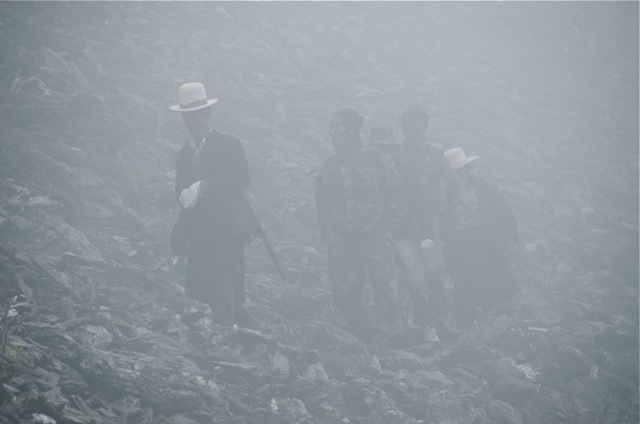
Our horsemen make their way through mists and a bit of healthy sleet to reach the lake to pay respects
Warming themselves with bowls of butter tea, they prepare to ascend and lay the juniper (if it cannot be burnt in the wet mists which drive from the west) by the lake.
Off they go disappearing quickly, piling up into more thickening sheets of stunning gloom. Songjè leads, because he is the only leader and this seems to have been a fact since he arrived. His white broad rimmed hat sits tilted on his head like a bizarre beacon moving up with hands clasped behind his back. In less than 20 minutes an intrepid pack of students has decided to join me to follow the horsemen up to the lake. They too wish to see the lake, even though tomorrow our entire troupe will make for it. This little group have the hunger which I have long known – a kind of impatience in the blood – to see this lake which they’ve heard so much about.
Thermoses filled with warm liquids, hoods tightened, and layers added we too enter up into the gloom of the heights.

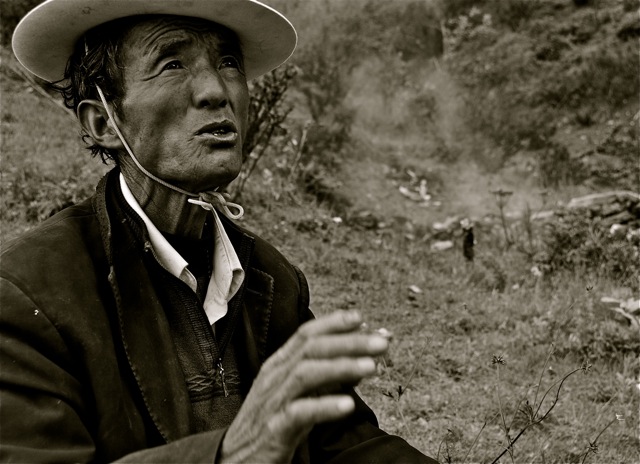
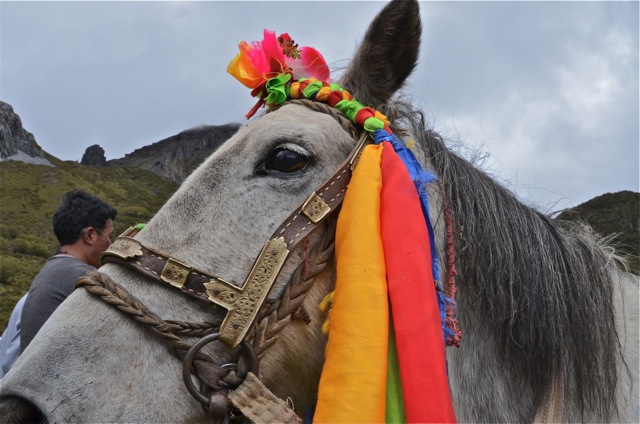
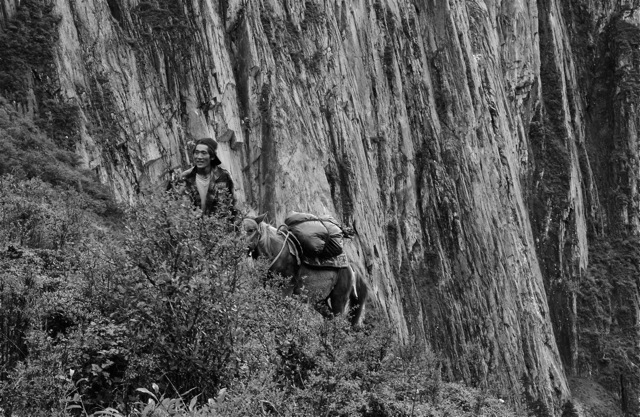

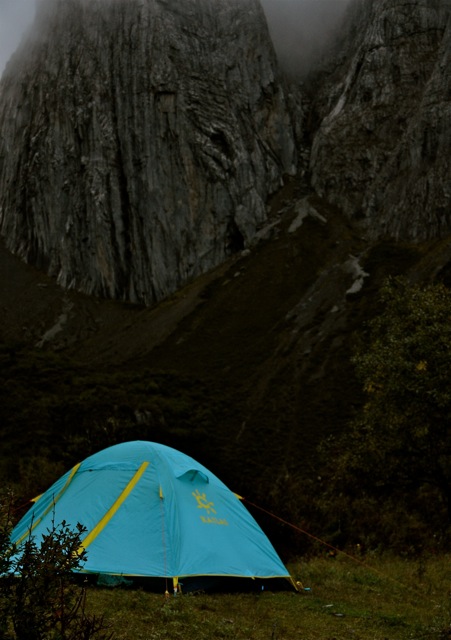
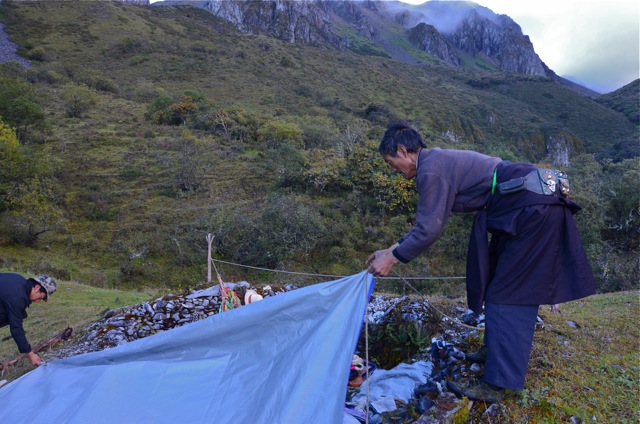
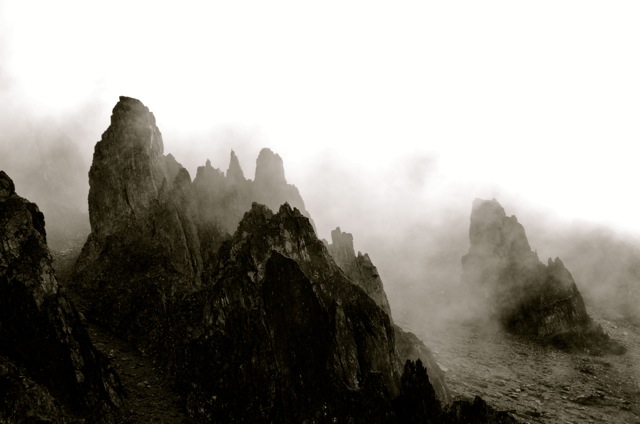
Excellent Reading Jeff!You are not only doing the Expeditions or trekking,but helping the unknowns to us,unknown Yunnan,to us.Our forefathers Ahom KIng Sukapha came from this Yunnan Province in 1215 A.D. and established his capital at Charaideu in 1228 AD in Assam,A north eastern State of India.Hope how Sukapha came to Assam. through which route,& perhaps you will come through this route!
Hi to you Mayur and thanks for the note. The more I dig in Yunnan, the more I hear of the links to ‘you’ over in Assam. Working on next year’s routes which will take me away from this end of the Himalayas and into your regions. We’ll share some tea from here when I do get over.
be well,
Jeff
Wonderful post Jeff. I’ve been reading you for a while (on an introduction from Leanne), but the writing here is particularly sharp. Looking forward to part 2
Many welcomes and thanks for the note Ted.
Part 2 arriving now.
Jeff